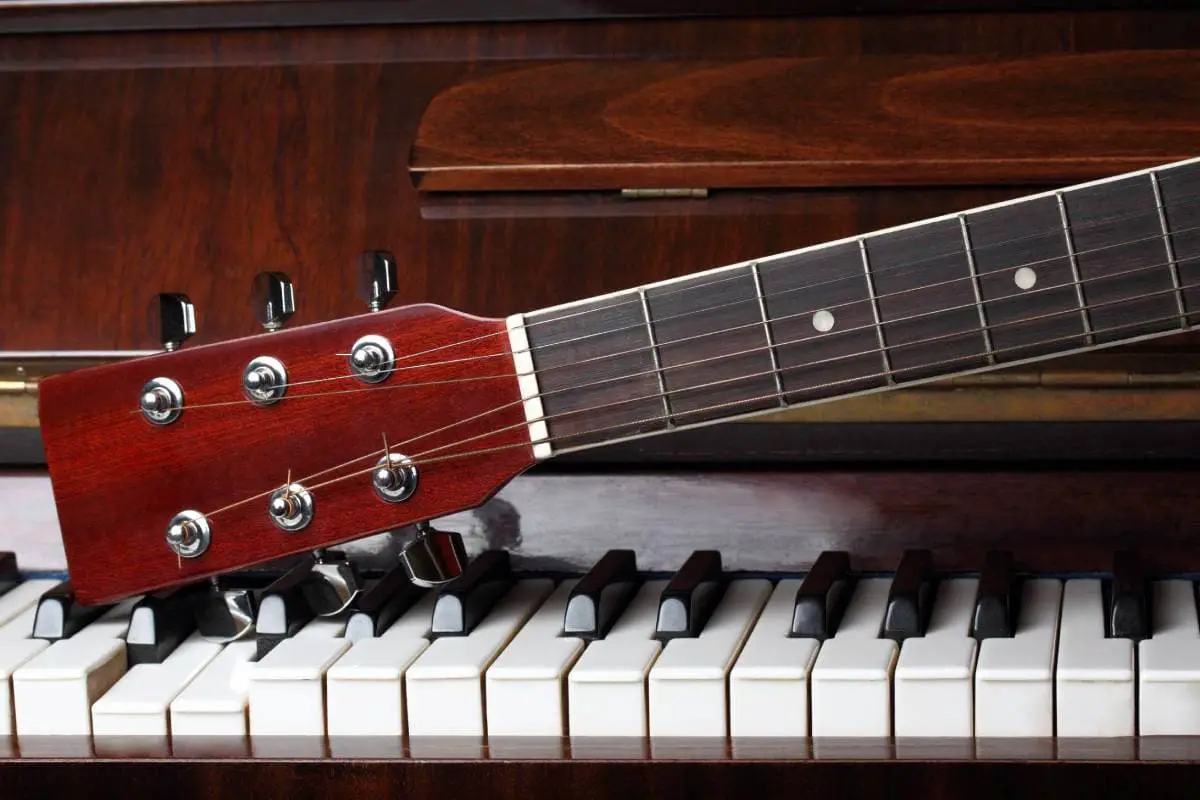Not every guitarist knows the obvious signs of a warped guitar neck, especially if you only started playing recently. Some signs of a warped neck are much easier to spot than others. Regular maintenance and thoroughly checking your guitar for any signs that the neck may be warped can save you a lot of work and money going forward.
A warped or bowed guitar neck is a condition where the neck of the guitar curves or bends in a concave manner, creating a noticeable gap between the strings and the frets. This can result in a higher action, making it more difficult to play the guitar.
Here are five obvious signs that your guitar neck is warped:
- Your guitar neck is twisted.
- The frets on your guitar are misaligned.
- You are experiencing fret buzz.
- Your guitar is out of tune.
- Your guitar has become wet.
A warped neck can affect your guitar’s sound, and the last thing you want is to have to buy a costly replacement. In this article, we will take a deeper look at these five signs and how catching them early on can save you a lot of work and money going forward.
If you want to find out what my recommended guitar gear is, then here is what I recommend on Amazon:
- Fender Cutaway Acoustic-Electric Guitar Bundle (MY FAVORITE GUITAR)
- Snark SN-8 Super Tight All Instrument Tuner (Easiest Tuner I’ve Used)
- 6 String Acoustic Guitar Capo (Best CAPO for quick changes)
- Dunlop Max Grip 1.0mm Nylon Picks (Thick Guitar Pick So You Don’t Lose Grip!)
- Universal Guitar Stand (Cheap & Minimalist Guitar Stand I Recommend)
- Levy’s 2″ Wide Quick Adjust Guitar Strap (Best Guitar Strap For Any Level)
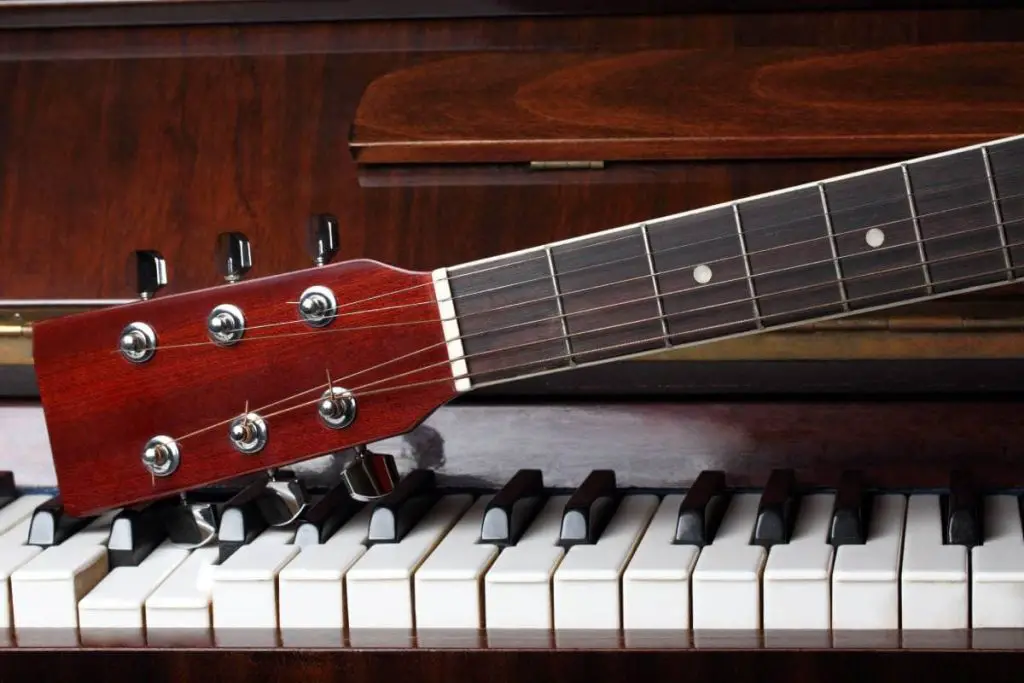
What Is A Warped Guitar Neck?
A warped guitar neck is when the neck of the guitar becomes bent or bowed, leading to issues with playing and sound quality. The neck of the guitar is made of wood, which can expand or contract due to changes in temperature and humidity levels.
In some cases, the tension of the strings can also cause the neck to bend. A warped guitar neck can cause problems such as high action, string buzz, and difficulty in playing. It’s important to monitor the humidity levels and store your guitar properly to prevent warping.
1. Your Guitar Neck Is Twisted Causing a Warped & Bowed Guitar Neck
Playing on a guitar with a warped neck is uncomfortable and sometimes impossible. If the neck is significantly warped, the strings will make a buzzing sound, and you won’t be able to tune your guitar. If the neck is only slightly warped, you might be able to play on it without any issues.
It is possible to fix a warped neck yourself if you catch it in time, but if your guitar’s neck is seriously damaged, you might have to take it to your local guitar shop to get it fixed or even replaced. Repair costs vary and can be extremely expensive, so it is always best to properly maintain your guitar to avoid a twisted neck.
The first and most obvious sign you should look out for is a twisted neck. You can follow these easy steps to check if your guitar neck is twisted:
- Take your guitar, place it on a table, and sit in front of the instrument. Your guitar can be fully strung for this, so don’t worry about removing the strings.
- Make sure the lighting in the room is good. Natural light is the best light source, so position the table and guitar in front of a window if possible.
- Bend down so that your eyes are level with the guitar, and look down the guitar neck, from the tuning keys to the sound hole.
- Turn the guitar around and check it from the other side, looking from the soundhole to the tuning keys.
You can spot a significantly warped guitar neck easily. One side of the guitar neck will be lower than the other, meaning the middle of the neck will be higher than the body or headstock.
On the other hand, if your guitar neck shows only slight warping, you might not be able to see it as clearly. You can try using the shadows of the strings as a guide to see if there is a warp, but this might be difficult for the untrained eye.
If you can’t see any warp but are sure that there is something wrong with the neck of your guitar, you can take it to your local guitar shop. They will usually have an expert who can look at your guitar for you; however, it is possible to play the guitar with a slight twist without any issues.
Straightening a Twisted Guitar Neck
Straightening a twisted guitar neck is possible; you will, however, need the right tools for the job. Repair costs can be expensive, but if you aren’t sure that you can fix your guitar neck yourself, it is better to take it to a repair shop because you might damage it more.
If you are a handy person and enjoy doing DIY projects and woodwork, fixing your guitar’s twisted neck should be easy and maybe even fun.
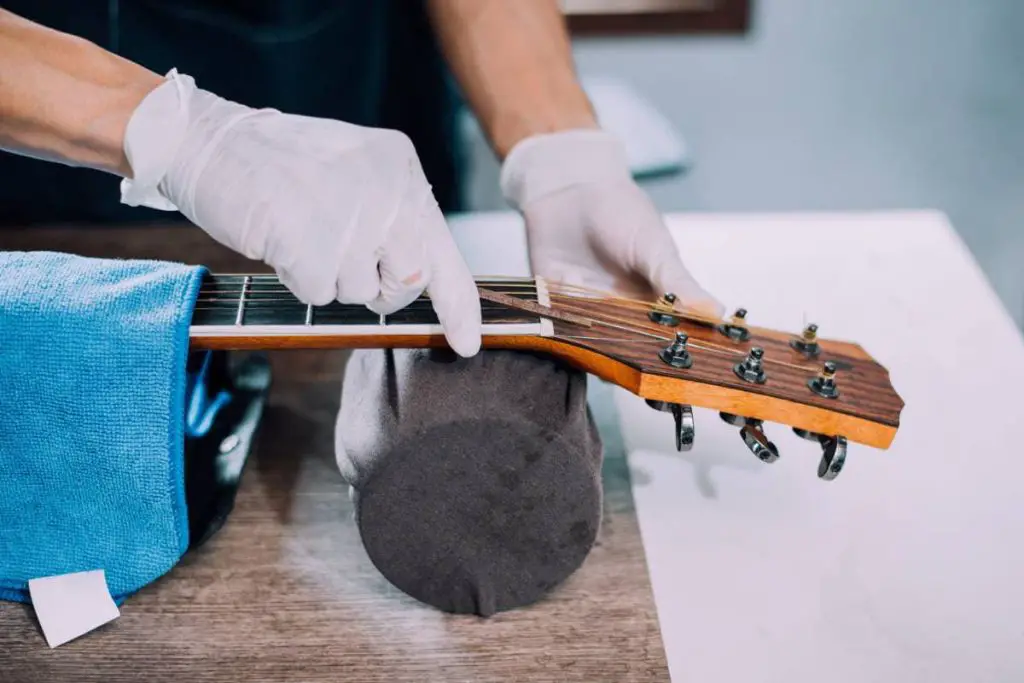
You can use heat and pressure to correct the twist in your guitar neck.
- Start by removing the strings from your guitar and placing them somewhere for safekeeping. Do not bend them as this can cause them to break next time you are playing.
- Now remove the fretboard. You can do this by using the heat from a clothing iron to melt the glue.
- Once you have removed the fretboard, you can secure the guitar’s neck in your straightening jig. If you don’t have a jig, you can use your woodworking skills to build one or use some clamps instead.
- Cover your guitar neck in a sheet thick enough to protect the wood. The covering should also be thin enough to let the heat through.
- Use a clothes iron without steam or water to heat the twisted neck. Wood is a natural material that can be pulled back into its original shape when heated. Do this slowly over 10 minutes as you do not want to damage the guitar neck, and wear gloves to protect your hands. You will feel when the entire neck feels warm to the touch.
- Straighten the warmed neck by placing it in the clamps. The first clamp should fit just below the nut, and the second clamp should connect just above the neck’s heel. Gradually increase pressure on the clamps until the neck is straight.
- Once the guitar neck is straight, you can let it cool down and put your fretboard and strings back on. It’s best to leave the neck overnight to cool. Be careful not to press the neck while it is cooling down, as you do not want to twist it again.
This process is not the easiest repair to do yourself, but it is possible. Unfortunately, it can also damage the neck, making the warp even worse, so it is always best to take your guitar to a repair shop if you don’t have sufficient experience or technical abilities.
2. The Frets on Your Guitar Are Misaligned Causing a Warped & Bowed Guitar Neck
Another sign that you have a warped guitar neck is that the frets will be misaligned. Spotting this sign might be slightly confusing for a novice, but if you have been playing for a while, you should easily be able to spot it.
Using the same technique described above, look down the neck of your guitar to ensure that the frets are aligned. You can place a neck rest under the neck to make sure your guitar doesn’t move. Guitar neck rests are easy to make, or you can buy them online or from your local guitar shop.
If some frets are higher than the others or look like a staircase, your guitar neck is warped (how to fix a warped guitar neck). The upper frets on your guitar neck should be perfectly aligned (Related article: electric guitar for small hands).
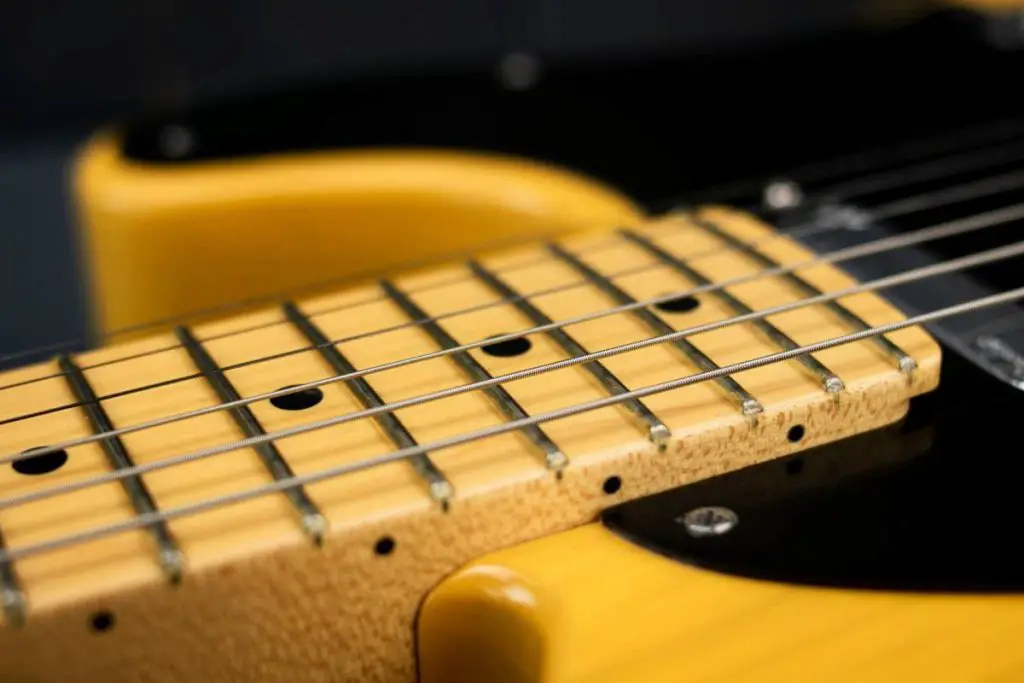
3. You Are Experiencing Fret Buzz Causing a Warped & Bowed Guitar Neck
If you are experiencing fret buzz when playing your guitar, there is a good chance that the neck is warped. It is also possible that a faulty nut can cause the buzz, so always check the nuts to ensure they are fine.
You will constantly hear an annoying buzzing sound when playing, and not all of the notes will ring out.
Look at your guitar neck from the side. The distance between the fretboard and the strings should be the same throughout the neck of the guitar. The strings should not be pressing on the fretboard anywhere.
Here is an informative YouTube video showing you some of the reasons why you can be experiencing fret buzz, including a twisted neck and how it sounds.
If your strings are touching the fretboard, there is not enough relief on the neck of your guitar. This issue can occur for a variety of reasons. You might be keeping your guitar in a cold or excessively warm environment when not playing it. If it is really cold where you live, the humidity will be lower, and if it gets scorching hot, the humidity will increase significantly.
You need to keep your guitar at the correct humidity, and if you expose it to high or low humidity, it can dry out or get wet, which leads to neck warping.
You should also be careful when changing your strings or tuning your guitar. Going from a low gauge string to a high gauge string or over tuning it can cause extra tension on the neck, which can cause it to warp.
When experiencing fret buzz, you can try to adjust the truss rod to correct the tension.
Adjusting the Truss Rod
It is possible to adjust your truss rod if you believe it will solve your problem, but you must be extremely careful. You must carefully adjust your truss rods as they can easily snap if too much pressure is applied.
Make sure you know what you are doing before you start. You get single-action and dual-action truss rods and many different brands of each. You also need to know your truss rod measurements and have the right tools to adjust the truss rod.
Different truss rods require different tools, but you will most likely need the following items:
- Screwdriver – Not all truss rods have a cover, but if your guitar’s truss rod has one, you will need a screwdriver to loosen it.
- Hex tool – Depending on the truss rod installed in your guitar, you might need a hex tool like this Klein Tools Hex Key Set (available on Amazon.com) to adjust it. This set has two key positions, and the ends are square-cut to prevent slippage. It includes different sizes, and the tool can easily fit in your guitar repair kit.
- Truss rod wrench – You can get the Vencetmat Guitar Allen Wrench Set (available on Amazon.com) to help you adjust your truss rod. The set includes various-sized gauges, and two lengthened wrenches with ball ends for guitars with narrow or deep truss rods. Manufacturers craft these wrenches from carbon steel, which is durable and will make a great addition to your repair kit.
- String height gauge – This is a must-have tool for every serious guitarist. You can get this Baroque String Action Ruler (available on Amazon.com) to ensure all your strings are at the proper distance from the frets. Manufactured from stainless steel, it is also durable. It can be used for your acoustic, electric, or bass guitar (Question: Can Bass Guitars Have Whammy Bars?) and shows measurements in inches and millimeters.
Inspect your guitar neck again so that you are sure how to adjust your truss rod. Place it on a table, look at it from the sound hole to the tuning keys, and then repeat the process from the other side as described above.
- If there is too much relief, the neck will be bending upwards, almost like it is bending in on itself. In this scenario, you will slowly and carefully turn the nut clockwise to increase the tension.
- If there is too much tension on the neck, it will bend backward. In this case, you need to release some of the tension so you will turn the nut counterclockwise.
When adjusting your truss rod, make sure to do it slowly, and keep an eye on your guitar neck. As soon as the neck levels out, stop adjusting the truss rod. Over tightening the truss rod can cause your guitar neck or adjustment nut to break, resulting in a costly repair.
Here is an interesting YouTube video showing how to adjust your truss rod to ensure your guitar has a straight neck.
4. Your Guitar Is Out of Tune Causing a Warped & Bowed Guitar Neck
As a guitarist, you might need an electric tuner to tune your guitar perfectly, but you should be able to hear when your guitar is out of tune. As we play, the strings lose tension and sometimes need to be tuned, this is normal, but if you constantly have to tune your guitar, you might have a problem.
If your guitar neck is warped, it is almost impossible to tune your guitar. Some frets may sound good, while others will be completely out of tune, and no matter how hard you try, you won’t be able to tune it.
If you don’t have an electric tuner, you can get this D’Addario Accessories Headstock Guitar Tuner (available on Amazon.com) to help you ensure that your guitar is always tuned perfectly. It is lightweight and simply clips onto your guitar. It is highly accurate and easy to read as it has a tri-color backlit screen.
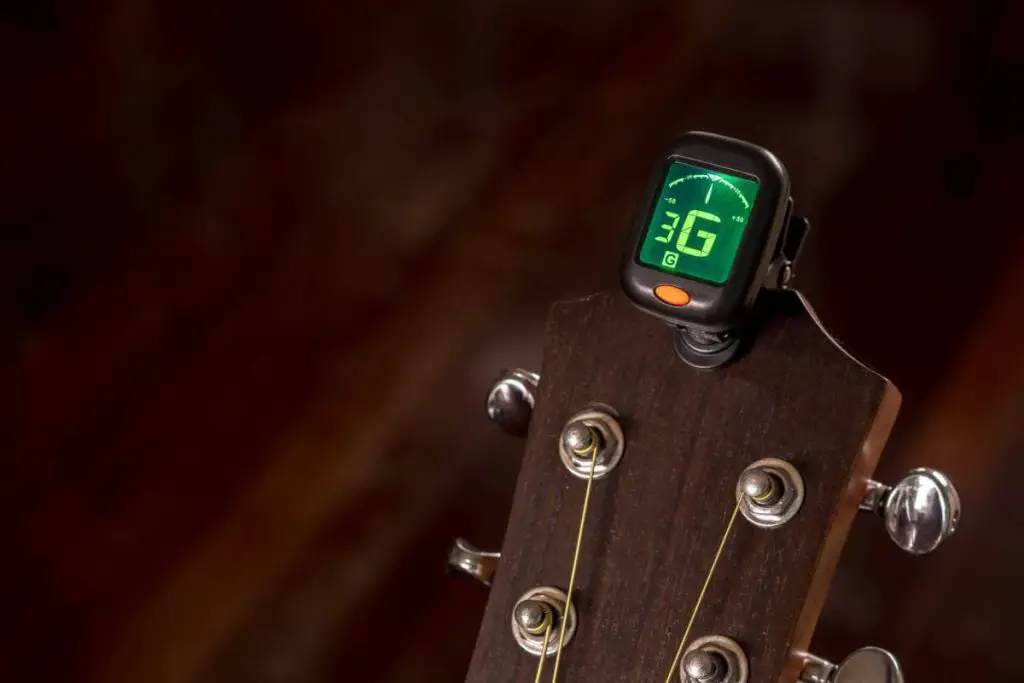
5. Your Guitar Has Become Wet Causing a Warped & Bowed Guitar Neck
The ideal relative humidity for a guitar is between 45% and 55%. If you expose your guitar to low humidity for an extended time, it will dry out, and if you expose it to high humidity, it will become wet.
The wood of your guitar will absorb the moisture, leading to all sorts of issues and structural damage. Sometimes people living in dry areas use soundhole humidifiers to prevent their guitar from drying out but instead over-humidifies their instrument.
We call this wet guitar, and although dry guitar happens more often, it can cause your guitar neck to warp.
Here are some things to look for if you think you have exposed your guitar has to high humidity levels for an extended period:
- Swollen wood – This is easy to spot if you keep a close eye on your guitar and will need immediate interventions
- Joint issues – If any of the joints on your guitar starts loosening, it might have absorbed too much moisture.
- Finish lifting – Moisture will cause the wood to swell but also cause your guitar’s finish to start lifting.
- Dull sound – Because of the water weight, your guitar will sound dull when playing it. Changing your strings will not help as the wet, swollen wood causes the dull sound, not the strings.
- Back warp – Because of the extra moisture, the back of your guitar could warp. You can easily check this with a straight ruler.
Any of the above issues can lead to a warped guitar neck, so it is best to address them as soon as you become aware of the problem.
The best thing to do is to keep your guitar in a hardshell case when you are not playing it. Don’t store your guitar in the basement or garage; loosen the strings before packing it away if you aren’t planning to play it for a while.
You can buy a humidifier, dehumidifier, and a hygrometer to ensure that you always keep your guitar at the ideal relative humidity.
Dry Guitar Signs
Living in an extremely cold area can cause the humidity levels to drop, and many people will turn to appliances like heaters to warm up their houses. Low humidity can cause your guitar to dry out and even crack.
Never place your guitar close to any heat source when warming up your house, as this can also cause the neck to warp.
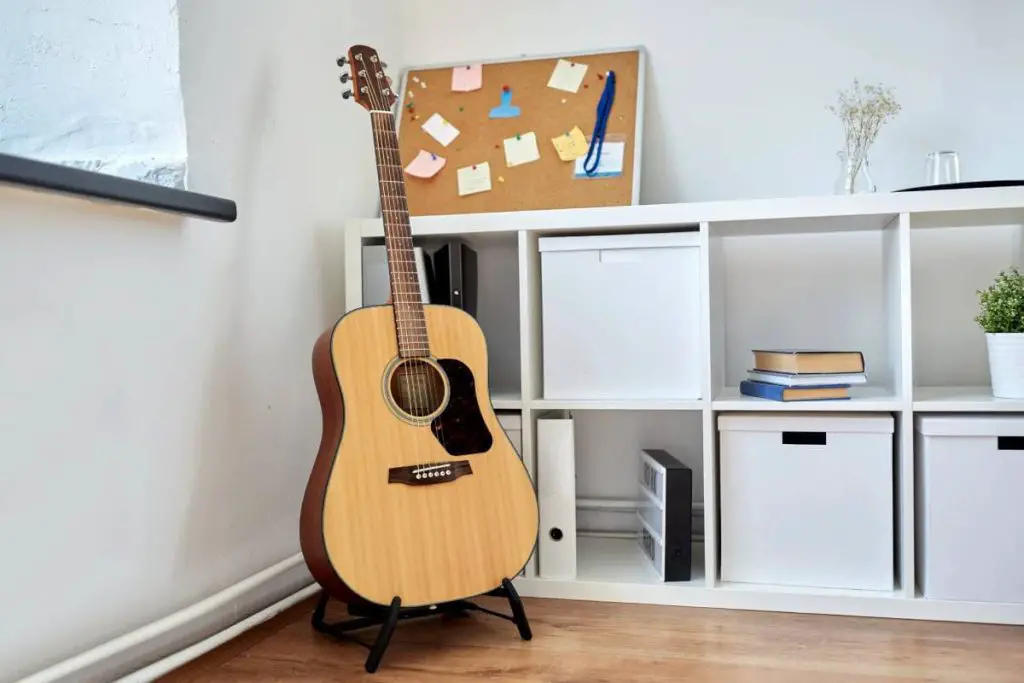
If you think you have exposed your guitar to low humidity levels for a long time, you can watch out for these dry guitar signs:
- Sharp fret ends – As your guitar dries out, the fret ends can become sharp and start sticking out.
- String buzz – This is the same as fret buzz. There isn’t enough space between the strings and the fretboard, causing the strings to touch the fretboard, making a buzzing sound.
- Shrinking fingerboard – The fingerboard can shrink in width, which you can pick up by measuring the board or picking it up by eye if it is significant.
- Cracks – As the wood dries out, cracks can form on the guitar’s body.
- Joint issues – A dry guitar can pick up many issues, including loose joints.
When your guitar becomes extremely dry, the neck bows forward and needs to be fixed by adding moisture and adjusting the truss rod.
What causes a warped guitar neck?
A warped guitar neck can be caused by several factors, including changes in temperature and humidity, excessive tension from the strings, or a manufacturing defect.
When exposed to changes in temperature and humidity, the wood in the neck can expand or contract, causing the neck to bend or warp. This can be especially problematic in climates with large fluctuations in temperature and humidity.
Excessive tension from the strings can also cause the neck to warp. If the strings are too tight, they can pull the neck forward, causing it to bend or bow. Conversely, if the strings are too loose, the neck may curve backwards.
Finally, a manufacturing defect or poor craftsmanship can also result in a warped guitar neck. If the wood is not properly dried or seasoned before the guitar is built, the neck may warp over time. Similarly, if the neck is not properly reinforced or supported, it may bend or bow under the tension of the strings.
To prevent a warped guitar neck, it’s important to store the guitar in a controlled environment with stable temperature and humidity levels. It’s also important to use the correct string tension and to have the guitar regularly maintained and adjusted by a qualified technician.
How to Fix a Warped Guitar
Steps to fix a warped guitar:
- Assess the severity of the warp
- Loosen the strings
- Adjust the truss rod
- Re-tune and monitor the guitar
An explanation of each step:
- Assess the severity of the warp: The first step in fixing a warped guitar is to assess the severity of the problem. This will determine the extent of the repairs needed and whether or not you can fix the problem yourself or if it requires professional attention.
- Loosen the strings: Before making any adjustments, it’s important to loosen the strings on the guitar. This will reduce the tension on the neck and make it easier to adjust the truss rod.
- Adjust the truss rod: The truss rod is a metal rod that runs through the center of the neck and helps to counteract the tension from the strings. To adjust the truss rod, you will need to locate the adjustment point on the headstock of the guitar and use an appropriate tool, such as an Allen wrench, to make small adjustments. The goal is to straighten the neck, but it’s important to make gradual adjustments and check the progress frequently to avoid overcompensating.
- Re-tune and monitor the guitar: Once you have made the necessary adjustments to the truss rod, you can re-tune the guitar and monitor it for any further warping. It’s important to keep the guitar in a controlled environment with stable temperature and humidity levels to prevent further warping.
Note: If the warp is severe or the truss rod adjustments do not correct the problem, it’s important to seek professional attention from a qualified guitar technician or luthier. Attempting to fix a severely warped guitar on your own can cause further damage to the instrument.
What Does a Warped Guitar Neck Look Like?
A warped guitar neck may appear to have a visible bow or curvature, either forward or backward, when viewed from the side. This can cause high or low action, fret buzzing, tuning problems, and warping at the headstock or heel. The severity and type of the warp can affect how the guitar looks and plays.
A warped guitar neck may look different depending on the severity and type of the warp. Here are some common signs of a warped guitar neck:
- Visible bowing or curvature: The neck may appear to have a noticeable bow or curvature, either forward or backward, when viewed from the side.
- High or low action: A warped neck can cause the strings to be positioned higher or lower than usual, making the guitar more difficult to play.
- Fret buzz: If the neck is warped, the strings may buzz against the frets, particularly in the middle of the neck.
- Tuning problems: A warped neck can also cause tuning issues, as the tension on the strings may be uneven across the neck.
- Warping at the headstock or heel: In some cases, the warping may be concentrated at the headstock or the heel of the neck, rather than along the entire length.
It’s important to note that not all of these symptoms are necessarily caused by a warped neck, and other factors such as a faulty bridge or nut can also contribute to these issues. If you suspect that your guitar neck is warped, it’s best to have it assessed by a qualified guitar technician or luthier.
What Does a Warped Guitar Neck Sound Like?
A warped guitar neck can affect the intonation, causing the guitar to sound out of tune even when properly tuned. The strings may also buzz or rattle against the frets, resulting in an unpleasant buzzing sound. In addition, certain notes may sound muted or dead, and the sustain may be reduced.
A warped guitar neck may affect the sound of the guitar in various ways, depending on the severity and type of the warp. Here are some common sound issues that may be caused by a warped guitar neck:
- Intonation problems: A warped neck can affect the intonation of the guitar, making it sound out of tune even when properly tuned. This can cause the guitar to sound off or discordant.
- Buzzing or rattling: If the strings are too close to the frets due to the warping of the neck, they may buzz or rattle against the frets when played, resulting in an unpleasant buzzing sound.
- Muted or dead notes: A warped neck can also cause certain notes to sound muted or dead, particularly in the middle of the neck where the strings may be lower than usual.
- Reduced sustain: The warping of the neck can also affect the sustain of the guitar, causing notes to fade out more quickly than usual.
It’s important to note that not all sound issues are necessarily caused by a warped neck, and other factors such as a faulty bridge or nut can also contribute to these issues. If you suspect that your guitar neck is warped and it’s affecting the sound of your guitar, it’s best to have it assessed by a qualified guitar technician or luthier.
Warped & Bowed Guitar Neck FAQ
How do you fix a bowed neck and warped neck on a guitar?
Fixing a bowed or warped neck on a guitar typically requires adjusting the truss rod, which is a metal rod that runs through the neck of the guitar. Here are the general steps to follow:
- Loosen the strings: Before making any adjustments to the truss rod, it’s important to loosen the strings to relieve tension on the neck.
- Identify the direction of the bow or warp: Look down the neck from the headstock to the body of the guitar and identify the direction of the curve.
- Adjust the truss rod: Using an appropriate tool, such as an Allen wrench, adjust the truss rod in the direction that will straighten the neck. This is typically done by turning the rod clockwise to tighten and straighten the neck, or counterclockwise to loosen and create more bow.
- Check the neck relief: After making adjustments to the truss rod, check the neck relief by pressing down on the first and last frets and measuring the gap between the string and the frets at the midpoint of the neck. A general rule of thumb is to aim for a gap of around 0.010 to 0.014 inches.
- Re-tune and test: Once you’re satisfied with the neck relief, re-tune the guitar and test the playability and intonation. If necessary, make additional adjustments to the truss rod until the neck is properly straightened.
It’s important to note that adjusting the truss rod can be a delicate process, and if you’re unsure about how to proceed or if the neck is severely warped or bowed, it’s best to take the guitar to a professional luthier for repair.
What does a warped guitar neck look like?
A warped guitar neck can have different visual characteristics depending on the extent and nature of the warping, but there are a few common signs to look for. These can include:
- Visible curvature: A warped neck may appear to be visibly curved or bent in one direction, creating a concave or convex shape.
- High or low action: Warping can cause the strings to sit higher or lower than normal, making it difficult to play the guitar comfortably.
- Fret buzzing: If the neck is warped, it can cause frets to buzz when playing certain notes or chords.
- Intonation issues: Warping can also cause intonation problems, where the guitar may not play in tune with itself across the fretboard.
If you suspect that your guitar neck is warped, it’s a good idea to have it inspected by a professional luthier who can diagnose the issue and recommend the appropriate course of action.
What causes neck bow?
Neck bow, or neck warping, is typically caused by changes in temperature or humidity that can affect the moisture content of the wood. When the wood loses or gains moisture, it can expand or contract, which can cause the neck to warp or bow.
Some of the most common causes of neck bow include:
- Changes in temperature and humidity: Fluctuations in temperature and humidity can cause the wood in the neck to expand or contract, which can lead to warping or bowing.
- Improper storage: Guitars that are not stored properly, such as in a damp or humid environment, can be more prone to neck warping.
- Tension from the strings: The tension from the strings can also cause the neck to warp over time, especially if the guitar is not properly adjusted or maintained.
- Poor quality or damaged wood: Guitars made from poor quality wood or with damaged necks can be more prone to warping or bowing.
To prevent neck bow, it’s important to store your guitar in a dry, stable environment, and to have it regularly inspected and adjusted by a professional luthier. It’s also a good idea to use a humidifier or dehumidifier to regulate the humidity level in your guitar’s storage space, especially if you live in an area with extreme temperature or humidity fluctuations.
Should guitar neck be straight or bowed?
A guitar neck should not be completely straight or bowed, but instead should have a slight curve or relief to allow for proper playability and intonation. This slight curvature is achieved through the use of a truss rod, which is a metal rod that runs through the center of the neck and can be adjusted to provide the appropriate amount of relief.
If the neck is completely straight, it can cause the strings to buzz against the frets or create intonation problems, while a neck that is excessively bowed can make the guitar more difficult to play and cause issues with action and intonation. The ideal amount of relief can vary depending on the player’s preference and playing style, but a general rule of thumb is to aim for a gap of around 0.010 to 0.014 inches between the string and the frets at the midpoint of the neck.
If you’re unsure about whether your guitar neck has the appropriate amount of relief, it’s a good idea to have it inspected and adjusted by a professional luthier. They can diagnose any issues and recommend the appropriate course of action to ensure that your guitar is properly set up for optimal playability and sound.
How do you know if your guitar neck is warped?
A warped guitar neck can cause a variety of issues with playability and intonation, and there are a few signs that can indicate whether your guitar neck is warped. Here are some common signs to look for:
- Visible curvature: One of the most obvious signs of a warped neck is a visible curvature or bowing. You can check for this by sighting down the neck from the headstock to the body of the guitar.
- High or low action: A warped neck can cause the strings to sit higher or lower than normal, making it difficult to play the guitar comfortably.
- Fret buzzing: If the neck is warped, it can cause the strings to buzz against the frets, especially when playing certain notes or chords.
- Intonation issues: Warping can also cause intonation problems, where the guitar may not play in tune with itself across the fretboard.
How much bow should a neck have?
A guitar neck should have a slight curve or relief to allow for proper playability and intonation, but the amount of bow can vary depending on the player’s preference and playing style. A general rule of thumb is to aim for a gap of around 0.010 to 0.014 inches between the string and the frets at the midpoint of the neck.
This gap is typically measured by pressing down on the first and last frets of the guitar and measuring the gap between the string and the frets at the midpoint of the neck.
It’s important to note that the ideal amount of bow can vary depending on the type of guitar, the string gauge, and other factors. If you’re unsure about whether your guitar neck has the appropriate amount of relief, it’s a good idea to have it inspected and adjusted by a professional luthier. They can diagnose any issues and recommend the appropriate course of action to ensure that your guitar is properly set up for optimal playability and sound.
How much does it cost to fix a warped neck?
The cost of fixing a warped neck can vary depending on the extent of the damage and the type of repair required. If the neck can be corrected through a simple truss rod adjustment, the cost may be relatively low, typically ranging from $20 to $50.
However, if the neck is severely warped or requires more extensive repair or replacement, the cost can be much higher. In these cases, the cost can range from $100 to $500 or more, depending on the type of repair required, the expertise of the repair technician, and other factors.
If you want to find out what my recommended guitar gear is, then here is what I recommend on Amazon:
- Fender Cutaway Acoustic-Electric Guitar Bundle (MY FAVORITE GUITAR)
- Snark SN-8 Super Tight All Instrument Tuner (Easiest Tuner I’ve Used)
- 6 String Acoustic Guitar Capo (Best CAPO for quick changes)
- Dunlop Max Grip 1.0mm Nylon Picks (Thick Guitar Pick So You Don’t Lose Grip!)
- Universal Guitar Stand (Cheap & Minimalist Guitar Stand I Recommend)
- Levy’s 2″ Wide Quick Adjust Guitar Strap (Best Guitar Strap For Any Level)
Related Posts:

